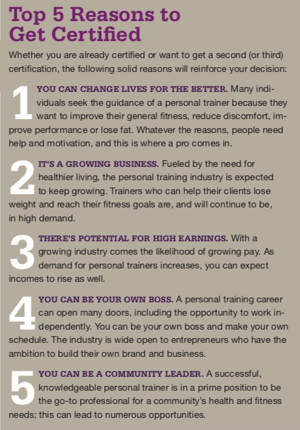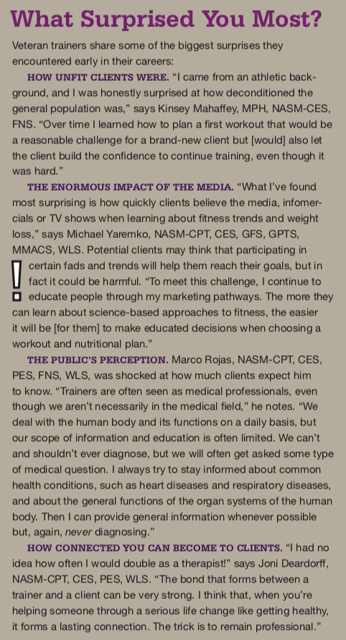Originally published in the Winter 2020 issue of American Fitness Magazine.
After “James” earned his exercise physiology degree, he was eager to get certified as a personal trainer and begin his career. A college athlete, he had dreams of putting clients through rigorous programs that yielded results, and he envisioned owning his own studio within 5 years.
Two years into his personal training career, however, James realized he needed to add more tools to his toolbox. His education and certification had given him a strong foundation, but he wanted to refine his career. Although he considered himself a tech wiz, translating the data from clients’ wearables into programming was proving to be a struggle, and, speaking of programming, James hadn’t anticipated how unfit people would be or how little they would know about nutrition. He decided he needed to redefine himself if he was going to succeed in a field he was passionate about.
While James is a fictional personal trainer, his dilemma is all too real for many who enter the fitness industry with high hopes of making a difference. But the reality facing new trainers can be a positive wake-up call for those who want to excel in this exciting profession. The industry is still relatively young and, thanks to forward-thinking people who’ve fought to legitimize personal training as a solid career option, a lot has transpired over the past 30 years to bring us to where we now are as an industry.
What qualities does a personal trainer need in order to thrive today? What advice do veteran trainers have for brand-new personal trainers? Is there such a thing as an “ideal” trainer? How do you become a personal trainer, exactly? Discover the focus areas that are pivotal to a personal trainer’s success.
A Personal Trainer Certification
What type of qualifications does a new personal trainer need? “At a minimum, a personal trainer would need a high school diploma or equivalent, CPR/AED certification and an accredited certification,” says Mike Fantigrassi, MS, NASM-CPT and Master Instructor, and director of product development for NASM in Chandler, Arizona.
“A [standard] personal trainer certification provides the baseline knowledge to begin a career and become employed,” adds Fantigrassi. “It is a way for employers and customers to confirm they are working with a qualified individual who takes his or her career seriously. Then, the requirement for ongoing continuing education helps ensure [that trainers] are staying up to date on the latest information.”
A personal trainer certification (like NASM's) even provides the opportunity to work as a PT internationally!

Before Kinsey Mahaffey, MPH, NASM-CES, FNS, Master Trainer and Instructor, and owner of LevelUp FitPro in Houston, got certified, she researched different options. “I heard from multiple employers that the NASM personal trainer certification was the gold standard in the industry,” she says. “The same is still true today.”
Some people wonder if they need an exercise or kinesiology degree to succeed. The short answer: not necessarily, but you do need to have a solid understanding of biomechanics and functional anatomy, which are taught in most certified personal trainer courses, notes Mahaffey.
“A degree in an exercise-related field is always helpful but not necessary to become a certified personal trainer,” says Fantigrassi. “The certification course contains all the fundamental information you need, and the real learning happens on the job when you are faced with new challenges. Those who continue to learn and seek out solutions to the problems they experience while on the job will excel.”
If your interest is piqued, you can find some great online NASM fitness certifications by following the link.
Business-Related Skills
Succeeding in the personal training industry is tougher than you may realize, says Nicole Lark, NASM-CES, and owner of Breathe Fitness in Edmonton, Alberta. “There is stiff competition, and being an educated and experienced trainer does not always correlate with success,” she says. “You also need to have marketing skills, social media presence, networking capabilities and business acumen to make a long-lasting career for yourself.”
Sales and Marketing
All trainers should take a sales training class to learn how to present the services they are trying to sell, advises Bill Ross, PhD, NASM-CPT, CES, PES, BCS, FNS, GFS, GPTS, MMACS, WLS, Master Trainer, life coach and nutritionist with Bill Ross Fit in Denver.
Marco Rojas, NASM-CPT, CES, PES, FNS, WLS, and owner of Move Right Training in New York City, agrees. “Before we get a client, we have to know how to sell ourselves to a client. Part of that is promoting your product and giving it value—the product being the trainer and the trainer’s knowledge as it relates to the client’s goals. If you can’t sell yourself,
no one will want to buy,” he says.
Another important skill is knowing how to price and package your services so that you can make a profit, says Mahaffey. “Also, understanding where and how to find your ideal client is crucial to success!” she adds.
Organization/Time Management
Every trainer needs to be organized and structured with regard to client workouts, session tracking [and] performance tracking, says Ross. Mahaffey says being organized and skilled at time management are key to maximizing your training schedule and staying on top of all appointments.
Technology
“Understanding technology is also necessary, with all of the [software] and apps [there are for tracking] client success, scheduling, workouts, nutrition, etc.,” says Mahaffey.
Kurt Gillon, NASM-SFS, WFS, who trains clients in the Atlanta area, forecasts that trainers will need to embrace wearable and data-tracking platforms and to incorporate them into their training soon.
Communication
Lark points out that excellent verbal and written communication skills will help with giving presentations, meeting clients, writing blogs, posting on social media and sending mailings to new and current clients.
People Skills
Veteran trainers mention again and again how crucial the interaction-oriented skills are. “Most trainers know how to teach a squat or a plank,” says Lark. “However, trainers who can relate to their clients and build a strong rapport with them will see the most rewards.”
Empathy
“My clients need to know that I understand what they’re going through and the experience they’re having,” says Joni Deardorff, NASM-CPT, CES, PES, WLS and Master Trainer, owner of Joni Deardorff Personal Trainer LLC in Frisco, Texas. “A good trainer should be able to put themselves into their clients’ shoes.”
If you are not naturally empathetic, you can develop this skill, says Lee Jordan, MS, who, with his wife, Beth, runs Fullest Living, a wellness company in Jacksonville Beach, Florida. Both are certified personal trainers. “A few key learnable skills that profoundly impact a trainer’s ability to be successful are often, mistakenly, considered ‘traits.’ The best example is empathy. This is a critical skill [needed] to gain, keep and grow clients. It doesn’t matter how much knowledge you have if the client doesn’t believe [he or she is] being heard and understood.”
Certified personal trainer Nathan White, CSCS, has been coaching, training and mentoring personal trainers on the Palos Verdes Peninsula, in California, for the past 8 years. “Most new trainers have relatively little life experience, as they’re between the ages of 23 and 30,” he explains. “The most glaring area has been their lack of self-awareness in expressing empathy toward their prospective clients. We spend a lot of time role-playing and practicing motivational interviewing skills. I also loan them leadership books that have helped me over the years to improve my coaching skills.”
Mental Flexibility
Trainers need to be adaptable to different personalities and still be themselves, explains Deardorff. “I have only had two clients whose personalities just really clashed with mine. Everyone else I’ve been able to get along with.”
Nutrition and Behavior Change
Do you need to become a nutrition expert to be a personal trainer? “Nutrition and exercise go hand in hand but are two different areas of knowledge and expertise and should be treated as such,” says Rojas. “Trainers should definitely educate themselves on nutrition. [But you can only] give general information, without prescribing a personalized diet program, unless you hold the proper nutrition credentials.”
 A basic understanding of nutrition can help you feel comfortable in giving clients general nutrition recommendations, notes Mahaffey. “However, getting a certification in nutrition can give you a better understanding of how to guide your clients—within your scope of practice—to reach their goals.”
A basic understanding of nutrition can help you feel comfortable in giving clients general nutrition recommendations, notes Mahaffey. “However, getting a certification in nutrition can give you a better understanding of how to guide your clients—within your scope of practice—to reach their goals.”
In addition to nutrition knowledge, behavior change basics are key. “Understanding these fundamentals is crucial to [trainers’] success rates, since most clients set goals that require a change in lifestyle [habits]—such as nutrition, sleep or exercise—not just three workouts a week,” says Mahaffey. “If you don’t know how to guide clients toward sustainable lifestyle change, they’ll never be able to get or keep the results they’re after.”
Specialization
Ask veteran trainers and almost all will say that focusing on a certain area or clientele has been key to their career success.
 “I definitely feel that a trainer needs a niche market,” says Michael Yaremko, NASM-CPT, CES, GFS, GPTS, MMACS, WLS, Master Trainer, and CEO of Yaremko Sports & Personal Training in Greensburg, Pennsylvania. “I work with professional and amateur ice hockey goalies, training for their specific movements and functions. It is a small niche that I have become proficient in, as I also coach goalies on the ice, as well.”
“I definitely feel that a trainer needs a niche market,” says Michael Yaremko, NASM-CPT, CES, GFS, GPTS, MMACS, WLS, Master Trainer, and CEO of Yaremko Sports & Personal Training in Greensburg, Pennsylvania. “I work with professional and amateur ice hockey goalies, training for their specific movements and functions. It is a small niche that I have become proficient in, as I also coach goalies on the ice, as well.”
Mahaffey earned a corrective exercise specialization that she believes is invaluable for all trainers. Beyond that, she recommends choosing a target area that fits the population you typically train—for example, weight loss.
You can even become a Lifestyle Coach through NASM and help clients lose weight.
“We all have an area of fitness that we find especially interesting and that excites us to train,” explains Rojas. “Get extra education in that area and become an expert in it without forgetting the foundational knowledge of anatomy and physiology that exercise is built on.”
Is There an Ideal Trainer?
To be successful, a new personal trainer needs to obtain the skills and education described above, but what makes an ideal trainer? Opinions vary.
“The characteristics of an ideal trainer begin with certification and education, a client-centered approach, and an understanding and commitment to an evidence-based approach to exercise design/coaching,” say the Jordans. “As part of this standard, trainers must be able to ‘be’ who they are, authentically, and to meet and accept others where they are, empathetically. Every trainer can be committed to this standard of excellence and, through a commitment to ongoing personal development, grow forward.”
How does Mahaffey define an ideal trainer? “One who loves helping others, prioritizes continuing education to stay fresh, seeks opportunities for [career] growth—whether that means [moving into] managerial positions or attaining additional certifications or qualifications as a trainer—and regularly takes time off to avoid burnout. One trainer can meet [all] these qualifications, but it takes intentionality and effort to have a plan on how to get there.”
 Yaremko thinks there is no one definition of the ideal trainer. “The concept of an ideal trainer is impossible to reach because, just like the ideal spouse, everyone has a different opinion on what that means,” he says. “Every client needs something a little different, and every trainer has to be true to his or her values while training or the sessions will not seem genuine. Based on [the individual’s] values and conduct, each trainer will then attract clients that are drawn to that style or technique. Therefore, one trainer will be unable to attract every type of client.”
Yaremko thinks there is no one definition of the ideal trainer. “The concept of an ideal trainer is impossible to reach because, just like the ideal spouse, everyone has a different opinion on what that means,” he says. “Every client needs something a little different, and every trainer has to be true to his or her values while training or the sessions will not seem genuine. Based on [the individual’s] values and conduct, each trainer will then attract clients that are drawn to that style or technique. Therefore, one trainer will be unable to attract every type of client.”
Deardorff also believes there is no set standard. “There is no ideal trainer. . . . Is that trainer ideal in the eyes of his or her clients? That’s what matters. Happy clients. Be who they need, be trustworthy and help them reach their goals.”
Toward a Successful Career
“Entering the personal training industry, I didn’t realize the potential that the career held,” says Mahaffey. “Personal trainers can train for their entire careers or branch out into a variety of other opportunities, such as specializing in a niche population, speaking, educating other fitness professionals, mentoring, writing for fitness publications or owning a business. The only limit on the potential of this career is the one that you place on it!”
Get an NASM Specialization
Fitness needs vary by individual as well as by age and stage of life. If you’re already a personal trainer, adding a fitness specialization can positively shape the future of your business. Taking this step has the potential to increase your client roster, expand your employment opportunities and raise your income. Plus, specializations provide valuable CEUs.
Specializations are also a good way to share your passion for fit- ness with others. Get the coveted credentials elite trainers have, and gain the skills, knowledge and confidence needed to help your clients succeed. Among the many choices: nutrition, behavior change, weight loss and more. Find out how to add to your credentials at nasm.org/continuing-education/fitness-specializations.

















